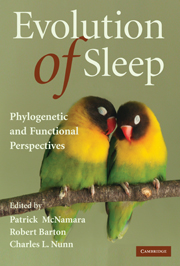Book contents
- Frontmatter
- Contents
- Contributors
- Acknowledgments
- Introduction
- 1 Ecological constraints on mammalian sleep architecture
- 2 Sleep in insects
- 3 Schooling by continuously active fishes: Clues to sleep's ultimate function
- 4 What exactly is it that sleeps? The evolution, regulation, and organization of an emergent network property
- 5 Evolutionary medicine of sleep disorders: Toward a science of sleep duration
- 6 Primate sleep in phylogenetic perspective
- 7 A bird's-eye view of the function of sleep
- 8 The evolution of wakefulness: From reptiles to mammals
- 9 The evolution of REM sleep
- 10 Toward an understanding of the function of sleep: New insights from mouse genetics
- 11 Fishing for sleep
- Index
- Plate section
- References
5 - Evolutionary medicine of sleep disorders: Toward a science of sleep duration
Published online by Cambridge University Press: 10 March 2010
- Frontmatter
- Contents
- Contributors
- Acknowledgments
- Introduction
- 1 Ecological constraints on mammalian sleep architecture
- 2 Sleep in insects
- 3 Schooling by continuously active fishes: Clues to sleep's ultimate function
- 4 What exactly is it that sleeps? The evolution, regulation, and organization of an emergent network property
- 5 Evolutionary medicine of sleep disorders: Toward a science of sleep duration
- 6 Primate sleep in phylogenetic perspective
- 7 A bird's-eye view of the function of sleep
- 8 The evolution of wakefulness: From reptiles to mammals
- 9 The evolution of REM sleep
- 10 Toward an understanding of the function of sleep: New insights from mouse genetics
- 11 Fishing for sleep
- Index
- Plate section
- References
Summary
Introduction
Evolutionary medicine is a relatively new field of inquiry that attempts to apply the findings and principles of evolutionary anthropology and biology to medical disorders (Armelagos, 1991; Cohen, 1989; Nesse & Williams, 1998; Stearns, 1999; Stearns & Koella, 2007; Trevathan, Smith, & McKenna, 1999, 2008; Williams & Nesse, 1991). Although a fair number of medical disorders have been explored from the evolutionary medicine perspective (see the collection of papers in Stearns, 1999, and Trevathan et al., 1999, 2008), sleep disorders have not been among them. This is unfortunate, as application of evolutionary theory to problems of sleep disorders will likely yield significant new insights into both the causes and solutions of all of the major sleep disorders.
In this chapter, we discuss several of these major sleep disorders as well as some of the less common ones. Our choice of which disorders to cover was rather arbitrary: we chose those where, we believe, evolutionary analysis is currently in a position to shed new light on the symptomatology of the disorder as well as on its potential ultimate causes. We were particularly interested in disorders that might also shed light on a potential science of sleep durations.
Why sleep durations? Time spent asleep is one of the most important aspects of sleep, as it is directly linked to the restorative qualities of sleep. If you do not get enough sleep, you do not feel well.
- Type
- Chapter
- Information
- Evolution of SleepPhylogenetic and Functional Perspectives, pp. 107 - 122Publisher: Cambridge University PressPrint publication year: 2009
References
- 1
- Cited by



